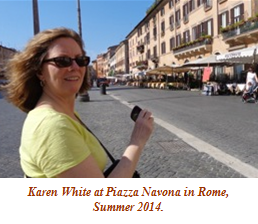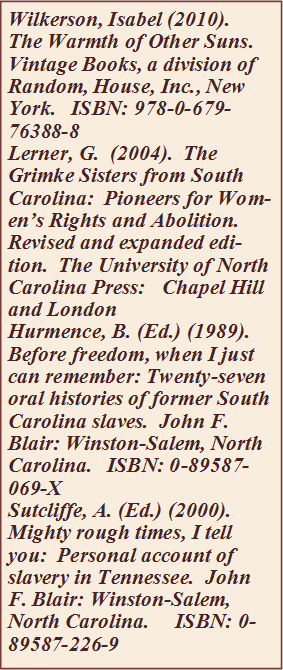Book
Review: The Warmth of Other Suns
Using history to support exploration
of past and current race relation issues.
Karen White, Ph.D.
 Summer may finally be
emerging in the Chicago area. And summer in Chicago
means incredibly good, free music festivals….such as the Gospel
Music Festival in May, the Blues Festival in June, and the Jazz
Festival in early September. Why do Chicago music festivals come
to mind in a review of Isabel Wilkerson’s The Warmth of Other
Suns? Because without the mass migration of American
Blacks from the US South to the North and West, Chicago might only
be “appreciated” for its extreme winter weather and blow hard
politics. Chicago culture was forever enriched by the
infusion of music originally developed in the American South by
enslaved Africans and their “freed” descendants. Wilkerson’s
book is about far more than the African American influence on
music in Chicago. It offers a view of American history that
is rarely recognized.
Summer may finally be
emerging in the Chicago area. And summer in Chicago
means incredibly good, free music festivals….such as the Gospel
Music Festival in May, the Blues Festival in June, and the Jazz
Festival in early September. Why do Chicago music festivals come
to mind in a review of Isabel Wilkerson’s The Warmth of Other
Suns? Because without the mass migration of American
Blacks from the US South to the North and West, Chicago might only
be “appreciated” for its extreme winter weather and blow hard
politics. Chicago culture was forever enriched by the
infusion of music originally developed in the American South by
enslaved Africans and their “freed” descendants. Wilkerson’s
book is about far more than the African American influence on
music in Chicago. It offers a view of American history that
is rarely recognized.
Wilkerson brings to life the Great
Migration that took place between 1915 and 1970, a journey that
followed along three train routes leaving the South to cities
along the eastern seaboard, the industrialized upper Midwest, and
Los Angeles and Oakland areas of California. Many European
Americans have a strong sense of the immigrant stories of their
own families, but few appreciate the challenges placed on African
Americans’ efforts to break free of the post-emancipation
oppression of poverty, the indentured servitude of sharecropping,
and the extreme inequities of the educational system in the South.
Although African Americans may have escaped the overt
discrimination of Jim Crow laws in the South, their efforts to
make a better life in the North and West were often thwarted by
subtle and outright prejudice in crowded cities where there was
intense competition for resources among White and Black
“immigrants”.
 The beauty of Wilkerson’s craft is evident in her presentation of
three individual stories of migration; each person from a
different decade of the Great Migration, each with a different
destination (Chicago, New York, and Los Angeles). The
unfairness of sharecropping economics, the threat of the Klan, and
the disrespect of one’s hard earned advanced education are all
made palpable in the stories of Ida Mae Brandon Gladney, George
Starling, and Robert Foster. In describing the lives
of these individuals in almost novel-like form, Wilkerson
engenders an appreciation of the motivation to leave one’s home in
the South and the tremendous courage required to take such risks.
The stories are imbedded in a deeply contextualized presentation
of the times and segments of black society in which each person
lived. Wilkerson conducted more than a thousand
interviews and consulted hundreds of printed sources.
Wilkerson’s masterful storytelling brings one to a new
appreciation of American history and why we might be looking at
today’s wrenching stories of frustration and violence in urban
settings.
The beauty of Wilkerson’s craft is evident in her presentation of
three individual stories of migration; each person from a
different decade of the Great Migration, each with a different
destination (Chicago, New York, and Los Angeles). The
unfairness of sharecropping economics, the threat of the Klan, and
the disrespect of one’s hard earned advanced education are all
made palpable in the stories of Ida Mae Brandon Gladney, George
Starling, and Robert Foster. In describing the lives
of these individuals in almost novel-like form, Wilkerson
engenders an appreciation of the motivation to leave one’s home in
the South and the tremendous courage required to take such risks.
The stories are imbedded in a deeply contextualized presentation
of the times and segments of black society in which each person
lived. Wilkerson conducted more than a thousand
interviews and consulted hundreds of printed sources.
Wilkerson’s masterful storytelling brings one to a new
appreciation of American history and why we might be looking at
today’s wrenching stories of frustration and violence in urban
settings.
Wilkerson covers seven decades of a continuous stream of
migration, and it should not escape us that although we are many
years past the “Civil Rights Era”, our society is struggling to
face an ugly scene of African Americans being unjustly arrested,
abused, and murdered at the hands of “authorities”.
These injustices placed in the political context of an African
American president, and now the second African American attorney
general, cause us all to wonder how to understand the enormous
advancements and shockingly slow progress for a group of Americans
who, as a group, have been in this land longer than most European
Americans. Our current graduate students have certainly
grown up in more integrated schools and peer groups, but may lack
an appreciation of how and why race relations in this country
remain such a painful, threatening topic to broach in a group
context. Perhaps Isabel Wilkerson’s book is an opportunity
for all of us to deepen our sense of history about American
culture. It may be one way to draw graduate students (and faculty
colleagues) into an exploration of diversity issues. Wilkerson’s
book invites an appreciation of our recent history and the
complexities of race relations. Her beautiful prose and deep
understanding of history should hold our minds open and make us
curious about the American experience in all of its shades and
stages.
Understanding today’s issues may require
us to step beyond our own time-locked point of view.
Consider exploring even brief segments of Wilkerson’s book for
group discussions. In addition, below are listed some
other books. One is about female abolitionists from South
Carolina. Two other books are from the perspectives of individuals
who were born into slavery. The Library of Congress sponsored the
Federal Writers’ Project which created work for jobless writers
and social workers to interview African Americans who had lived
under slavery. The interviewees were at least ten years old at the
time they were freed and were interviewed during the Great
Depression as they approached their 80s and 90s. Reading
historical work from the perspective of individuals who lived it
sometimes pulls us in to a space more conducive to reflection on
the human experience.
 Summer may finally be
emerging in the Chicago area. And summer in Chicago
means incredibly good, free music festivals….such as the Gospel
Music Festival in May, the Blues Festival in June, and the Jazz
Festival in early September. Why do Chicago music festivals come
to mind in a review of Isabel Wilkerson’s The Warmth of Other
Suns? Because without the mass migration of American
Blacks from the US South to the North and West, Chicago might only
be “appreciated” for its extreme winter weather and blow hard
politics. Chicago culture was forever enriched by the
infusion of music originally developed in the American South by
enslaved Africans and their “freed” descendants. Wilkerson’s
book is about far more than the African American influence on
music in Chicago. It offers a view of American history that
is rarely recognized.
Summer may finally be
emerging in the Chicago area. And summer in Chicago
means incredibly good, free music festivals….such as the Gospel
Music Festival in May, the Blues Festival in June, and the Jazz
Festival in early September. Why do Chicago music festivals come
to mind in a review of Isabel Wilkerson’s The Warmth of Other
Suns? Because without the mass migration of American
Blacks from the US South to the North and West, Chicago might only
be “appreciated” for its extreme winter weather and blow hard
politics. Chicago culture was forever enriched by the
infusion of music originally developed in the American South by
enslaved Africans and their “freed” descendants. Wilkerson’s
book is about far more than the African American influence on
music in Chicago. It offers a view of American history that
is rarely recognized.  The beauty of Wilkerson’s craft is evident in her presentation of
three individual stories of migration; each person from a
different decade of the Great Migration, each with a different
destination (Chicago, New York, and Los Angeles). The
unfairness of sharecropping economics, the threat of the Klan, and
the disrespect of one’s hard earned advanced education are all
made palpable in the stories of Ida Mae Brandon Gladney, George
Starling, and Robert Foster. In describing the lives
of these individuals in almost novel-like form, Wilkerson
engenders an appreciation of the motivation to leave one’s home in
the South and the tremendous courage required to take such risks.
The stories are imbedded in a deeply contextualized presentation
of the times and segments of black society in which each person
lived. Wilkerson conducted more than a thousand
interviews and consulted hundreds of printed sources.
Wilkerson’s masterful storytelling brings one to a new
appreciation of American history and why we might be looking at
today’s wrenching stories of frustration and violence in urban
settings.
The beauty of Wilkerson’s craft is evident in her presentation of
three individual stories of migration; each person from a
different decade of the Great Migration, each with a different
destination (Chicago, New York, and Los Angeles). The
unfairness of sharecropping economics, the threat of the Klan, and
the disrespect of one’s hard earned advanced education are all
made palpable in the stories of Ida Mae Brandon Gladney, George
Starling, and Robert Foster. In describing the lives
of these individuals in almost novel-like form, Wilkerson
engenders an appreciation of the motivation to leave one’s home in
the South and the tremendous courage required to take such risks.
The stories are imbedded in a deeply contextualized presentation
of the times and segments of black society in which each person
lived. Wilkerson conducted more than a thousand
interviews and consulted hundreds of printed sources.
Wilkerson’s masterful storytelling brings one to a new
appreciation of American history and why we might be looking at
today’s wrenching stories of frustration and violence in urban
settings.